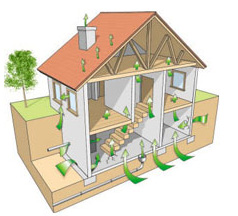Radon Levels During Iowa Winters
During the wintertime, many people become more concerned about silent killers like carbon monoxide in their homes. However, there is another invisible gas you may not know about that can be just as dangerous to you and your family. This is radon, the odorless, tasteless, and colorless gas that is the second leading cause of lung cancer, killing about 400 Iowans every year. This danger is especially prominent in the wintertime in your Iowa home.
How does radon enter your home? Normally, this gas decays from uranium in the soil and seeps upwards into your home through foundation cracks. The gas can also enter your home through well-water or other sources. So why is radon a bigger deal in the winter months?
 Less Ventilation: Because all of the windows and doors are kept closed during the wintertime, there is less opportunity for radon to escape. Instead, it builds up in the home.
Less Ventilation: Because all of the windows and doors are kept closed during the wintertime, there is less opportunity for radon to escape. Instead, it builds up in the home.- Greater Stack-Effect: The stack-effect is what occurs when the warmer air in the home rises and escapes out of the top – through the attic, chimney, etc. As this warmer air exits the home, radon- heavy air from the soil below rises to replace it.
- Warm Soil Under Home: Radon cannot easily rise through frozen ground. During the wintertime, the radon will instead rise through the warmer ground under your foundation and seep through cracks into your home.
These are a few reasons that it is good to be aware of the dangers of elevated radon levels during the winter months and to have your home tested.
How to Protect Your Home from Iowa Winter Radon Levels
Because those living in your home could suffer significant adverse health effects from prolonged radon exposure, it is important to have your home tested. If you are concerned about the Iowa radon risk during the wintertime in your home, have a short-term or long-term radon test done by the expert team at Ameriserv today.
 If you do find that your home has higher than average levels of radon, it is important to have the problem taken care of as soon as possible. Ameriserv offers professional radon mitigation services that can help to significantly reduce the levels of radon gas in your Iowa home.
If you do find that your home has higher than average levels of radon, it is important to have the problem taken care of as soon as possible. Ameriserv offers professional radon mitigation services that can help to significantly reduce the levels of radon gas in your Iowa home.
The radon mitigation system can consist of a hole in the foundation with a suction point on top and a PVC pipe system. The PVC is connected to the suction point, which pulls radon out of the ground and then carries the gas to a vent, where it can exit the home. A fan is then attached to make sure that the air moves in the right direction.
Contact us right away to learn about these and more radon solutions to reduce the Iowa radon risk in your home.
 Our Response to COVID-19
Our Response to COVID-19 

